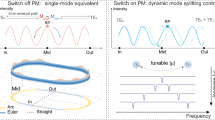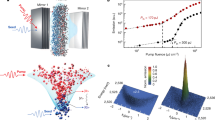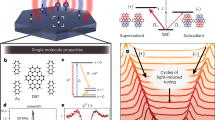Abstract
Physical systems with discrete energy levels are ubiquitous in nature and are fundamental building blocks of quantum technology. Realizing controllable artificial atom- and molecule-like systems for light would enable coherent and dynamic control of the frequency, amplitude and phase of photons1,2,3,4,5. In this work, we demonstrate a ‘photonic molecule’ with two distinct energy levels using coupled lithium niobate microring resonators and control it by external microwave excitation. We show that the frequency and phase of light can be precisely controlled by programmed microwave signals, using concepts of canonical two-level systems including Autler–Townes splitting, Stark shift, Rabi oscillation and Ramsey interference. Through such coherent control, we show on-demand optical storage and retrieval by reconfiguring the photonic molecule into a bright–dark mode pair. These results of dynamic control of light in a programmable and scalable electro-optic system open doors to applications in microwave signal processing6, quantum photonic gates in the frequency domain7 and exploring concepts in optical computing8 and topological physics3,9.
This is a preview of subscription content, access via your institution
Access options
Access Nature and 54 other Nature Portfolio journals
Get Nature+, our best-value online-access subscription
$29.99 / 30 days
cancel any time
Subscribe to this journal
Receive 12 print issues and online access
$209.00 per year
only $17.42 per issue
Buy this article
- Purchase on Springer Link
- Instant access to full article PDF
Prices may be subject to local taxes which are calculated during checkout




Similar content being viewed by others
Data availability
The data that support the plots within this paper and other findings of this study are available from the corresponding author upon reasonable request.
References
Morandotti, R., Peschel, U., Aitchison, J. S., Eisenberg, H. S. & Silberberg, Y. Experimental observation of linear and nonlinear optical Bloch oscillations. Phys. Rev. Lett. 83, 4756–4759 (1999).
Regensburger, A. et al. Parity–time synthetic photonic lattices. Nature 488, 167–171 (2012).
Lu, L., Joannopoulos, J. D. & Soljačić, M. Topological photonics. Nat. Photon. 8, 821–829 (2014).
Bandres, M. A. et al. Topological insulator laser: experiments. Science 359, eaar4005 (2018).
Joannopoulos, J. D., Villeneuve, P. R. & Fan, S. Putting a new twist on light. Nature 386, 143–149 (1997).
Capmany, J. & Novak, D. Microwave photonics combines two worlds. Nat. Photon. 1, 319–330 (2007).
Kues, M. et al. On-chip generation of high-dimensional entangled quantum states and their coherent control. Nature 546, 622–626 (2017).
McMahon, P. L. et al. A fully programmable 100-spin coherent Ising machine with all-to-all connections. Science 354, 614–617 (2016).
Lin, Q., Xiao, M., Yuan, L. & Fan, S. Photonic Weyl point in a two-dimensional resonator lattice with a synthetic frequency dimension. Nat. Commun. 7, 13731 (2016).
Chan, J. et al. Laser cooling of a nanomechanical oscillator into its quantum ground state. Nature 478, 89–92 (2011).
Hodaei, H. et al. Enhanced sensitivity at higher-order exceptional points. Nature 548, 187–191 (2017).
Chen, W., Özdemir, Ş. K., Zhao, G., Wiersig, J. & Yang, L. Exceptional points enhance sensing in an optical microcavity. Nature 548, 192–196 (2017).
O’Brien, J. L. Optical quantum computing. Science 318, 1567–1570 (2007).
Ramelow, S. et al. Strong nonlinear coupling due to induced photon interaction on a Si3N4 chip. Preprint at https://arxiv.org/abs/1802.10072 (2018).
Guo, X., Zou, C.-L., Jung, H. & Tang, H. X. On-chip strong coupling and efficient frequency conversion between telecom and visible optical modes. Phys. Rev. Lett. 117, 123902 (2016).
Sato, Y. et al. Strong coupling between distant photonic nanocavities and its dynamic control. Nat. Photon. 6, 56–61 (2012).
Clemmen, S., Farsi, A., Ramelow, S. & Gaeta, A. L. Ramsey interference with single photons. Phys. Rev. Lett. 117, 223601 (2016).
Xu, Q., Schmidt, B., Pradhan, S. & Lipson, M. Micrometre-scale silicon electro-optic modulator. Nature 435, 325–327 (2005).
Ayata, M. et al. High-speed plasmonic modulator in a single metal layer. Science 358, 630–632 (2017).
Shambat, G. et al. Ultra-low power fiber-coupled gallium arsenide photonic crystal cavity electro-optic modulator. Opt. Express 19, 7530–7536 (2011).
Enami, Y. et al. Hybrid polymer/sol-gel waveguide modulators with exceptionally large electro-optic coefficients. Nat. Photon. 1, 180–185 (2007).
Liu, M. et al. A graphene-based broadband optical modulator. Nature 474, 64–67 (2011).
Wade, M. T., Zeng, X. & Popović, M. A. Wavelength conversion in modulated coupled-resonator systems and their design via an equivalent linear filter representation. Opt. Lett. 40, 107–110 (2015).
Spreeuw, R. J. C., van Druten, N. J., Beijersbergen, M. W., Eliel, E. R. & Woerdman, J. P. Classical realization of a strongly driven two-level system. Phys. Rev. Lett. 65, 2642–2645 (1990).
Karpiński, M., Jachura, M., Wright, L. J. & Smith, B. J. Bandwidth manipulation of quantum light by an electro-optic time lens. Nat. Photon. 11, 53–57 (2017).
Armani, D. K., Kippenberg, T. J., Spillane, S. M. & Vahala, K. J. Ultra-high-Q toroid microcavity on a chip. Nature 421, 925–928 (2003).
Lee, H. et al. Chemically etched ultrahigh-Q wedge-resonator on a silicon chip. Nat. Photon. 6, 369–373 (2012).
Ji, X. et al. Ultra-low-loss on-chip resonators with sub-milliwatt parametric oscillation threshold. Optica 4, 619–624 (2017).
Bauters, J. F. et al. Ultra-low-loss high-aspect-ratio Si3N4 waveguides. Opt. Express 19, 3163–3174 (2011).
Konoike, R. et al. On-demand transfer of trapped photons on a chip. Sci. Adv. 2, e1501690 (2016).
Zhang, M., Wang, C., Cheng, R., Shams-Ansari, A. & Lončar, M. Monolithic ultra-high-Q lithium niobate microring resonator. Optica 4, 1536–1537 (2017).
Guarino, A., Poberaj, G., Rezzonico, D., Degl'Innocenti, R. & Gunter, P. Electro-optically tunable microring resonators in lithium niobate. Nat Photon. 1, 407–410 (2007).
Witmer, J. D. et al. High-Q photonic resonators and electro-optic coupling using silicon-on-lithium-niobate. Sci. Rep. 7, 46313 (2017).
Rueda, A. et al. Efficient microwave to optical photon conversion: an electro-optical realization. Optica 3, 597–604 (2016).
Savchenkov, A. A. et al. Tunable optical single-sideband modulator with complete sideband suppression. Opt. Lett. 34, 1300–1302 (2009).
Casanova, J., Romero, G., Lizuain, I., García-Ripoll, J. J. & Solano, E. Deep strong coupling regime of the Jaynes–Cummings model. Phys. Rev. Lett. 105, 263603 (2010).
Yanik, M. F. & Fan, S. Stopping light all optically. Phys. Rev. Lett. 92, 083901 (2004).
Shen, Y. et al. Deep learning with coherent nanophotonic circuits. Nat. Photon. 11, 441–446 (2017).
Wang, C., Zhang, M., Stern, B., Lipson, M. & Lončar, M. Nanophotonic lithium niobate electro-optic modulators. Opt. Express 26, 1547–1555 (2018).
Acknowledgements
This work was supported in part by National Science Foundation grants (ECCS1609549, DMR-1231319), Office of Naval Research MURI grant N00014-15-1-2761 and the Army Research Laboratory Center for Distributed Quantum Information W911NF1520067, Center for Integrated Quantum Materials (CIQM) and Harvard Office of Technology Development Accelerator. Device fabrication was performed at the Center for Nanoscale Systems at Harvard University.
Author information
Authors and Affiliations
Contributions
M.Z., C.W., S.F. and M.L. conceived the experiment. M.Z., C.W. and A.S.-A. fabricated the devices. M.Z. and Y.H. performed numerical simulations. M.Z., C.W. and T.R. carried out the experiments. M.Z. wrote the manuscript with contribution from all authors. M.L. supervised the project.
Corresponding author
Ethics declarations
Competing interests
M.Z., C.W. and M.L. are involved in developing lithium niobate technologies at HyperLight Corporation.
Additional information
Publisher’s note: Springer Nature remains neutral with regard to jurisdictional claims in published maps and institutional affiliations.
Supplementary information
Supplementary Information
Additional theory and experimental set-up, Supplementary Figures 1–6 and Supplementary References 1–5.
Rights and permissions
About this article
Cite this article
Zhang, M., Wang, C., Hu, Y. et al. Electronically programmable photonic molecule. Nature Photon 13, 36–40 (2019). https://doi.org/10.1038/s41566-018-0317-y
Received:
Accepted:
Published:
Issue Date:
DOI: https://doi.org/10.1038/s41566-018-0317-y
This article is cited by
-
Quantized topological pumping in Floquet synthetic dimensions with a driven dissipative photonic molecule
Nature Physics (2024)
-
Linear and phase controllable terahertz frequency conversion via ultrafast breaking the bond of a meta-molecule
Nature Communications (2024)
-
Versatile photonic molecule switch in multimode microresonators
Light: Science & Applications (2024)
-
Photonic-chip-based dense entanglement distribution
PhotoniX (2023)
-
All-fiber device for single-photon detection
PhotoniX (2023)



